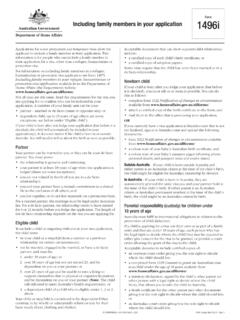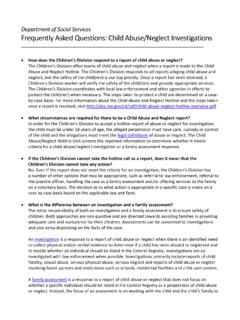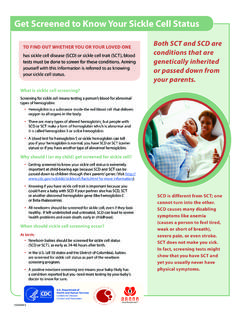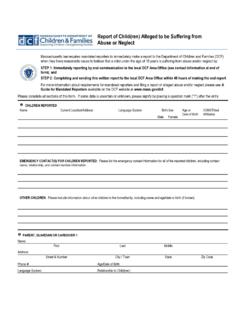Transcription of Plans of Safe Care for Infants With ... - Child Welfare
1 1 Children s Bureau/ACYF/ACF/HHS | | Email: | use disorders affect parents and other caregivers and can have negative effects on the health, safety, and well-being of children. One major area of concern is responding to the care and treatment needs of Infants with prenatal substance exposure and their families. To receive Child Abuse Prevention and Treatment Act (CAPTA) funds, States are required to ensure that they operate programs relating to Child abuse and neglect that include the following:1 Policies and procedures (including appropriate referrals to Child protection services systems and for other appropriate services) to address the needs of Infants born and identified as being affected by 1 42 5106a(b)(2)(B)(ii)-(iii), as amended by the Comprehensive Addiction and Recovery Act of 2016 ( 114-198) Plans of Safe Care for Infants With Prenatal Substance Exposure and Their Families WHAT'S INSIDEN otification/reporting requirementsAssessment of the infant and familyWhat is a plan of safe care?
2 1 Children s Bureau/ACYF/ACF/HHS | | Email: | STATUTES CURRENT THROUGH AUGUST 2019To find statute information for a particular State, go to for the infantServices for the parents or other caregiversResponsibility for development of the plan of safe careMonitoring Plans of safe care Summaries of State laws2 Children s Bureau/ACYF/ACF/HHS | | Email: | abuse or withdrawal symptoms resulting from prenatal drug exposure or Fetal Alcohol Spectrum Disorder (FASD), including a requirement that health-care providers involved in the delivery or care of such Infants notify the Child protective services (CPS) system of the occurrence of such condition of such Infants The development of a plan of safe care (POSC) for Infants born and identified as being affected by substance abuse or withdrawal symptoms or FASD to ensure the safety and well-being of such infant following his or her release from the care of health-care providers, including through addressing the health and substance use disorder treatment needs of the Infants and affected family or caregivers For this publication, statutes, regulations, and policies regarding requirements for providing appropriate care for these Infants were collected from across all States, the District of Columbia, and the territories.
3 And an analysis of the information informs the discussion that and technical assistance on POSCs are available through the Children s Bureau Regional Offices and the National Center on Substance Abuse and Child Welfare IS A PLAN OF SAFE CARE? A POSC is a plan designed to ensure the safety and well-being of an infant with prenatal substance exposure following his or her release from the care of a health-care provider by addressing the health and substance use treatment needs of the infant and affected family or caregiver. States have flexibility as to the implementation consideration of their POSCs. For example, the plan can be initiated in advance of the infant s birth by a designated community organization, including a substance use disorder treatment provider, the health-care provider at the birth hospital, or as part of the discharge process to ensure services are provided to the infant and the affected family or caregiver.
4 There is also variation as to whether the plan is developed by a State's CPS agency or Child Welfare agency. While the plan may address the immediate safety, health, and developmental needs of the affected infant, the POSC also must include the health and substance use disorder treatment needs of the affected parents or caregivers. It is best practice that the POSC be developed with input from the parents and caregivers and in collaboration with the health-care provider and other professionals and agencies involved in serving the affected infant and family. It also includes referrals to appropriate services that support the affected infant and his or her family or s Bureau/ACYF/ACF/HHS | | Email: | REQUIREMENTSLaws and/or policies in approximately 42 States and the District of Columbia require health-care providers to notify CPS when they are involved in the delivery or care of Infants who show evidence at birth of having been prenatally exposed to drugs, alcohol, or other controlled Specifically, reports are required when the infant or mother has a toxicology screen that is positive for substances and/or the infant exhibits physical, neurological, or behavioral symptoms consistent with prenatal substance exposure, withdrawal symptoms from prenatal substance exposure, or FASD.
5 While the notification to CPS is required by CAPTA, laws and/or policies in 14 States make clear that a notification is not considered a report of Child abuse or neglect unless there is evidence of maltreatment or risk of harm to the OF THE INFANT AND FAMILYUpon receiving a notification of an infant with prenatal substance exposure, the CPS agency makes an initial assessment to determine whether the infant meets the State's definition of Child abuse or neglect. If the infant does not meet criteria for abuse or neglect, best practice is to refer the family to a community agency for assessment of the family s needs. 2 The word "approximately" is used to stress the fact that States frequently amend their laws. This information is current through August 2019.
6 Alabama, Alaska, Arizona, Arkansas, California, Connecticut, Delaware, Florida, Georgia, Idaho, Illinois, Indiana, Iowa, Kansas, Kentucky, Louisiana, Maine, Maryland, Massachusetts, Michigan, Minnesota, Mississippi, Missouri, Montana, Nebraska, Nevada, New Hampshire, New Jersey, New Mexico, New York, North Carolina, North Dakota, Ohio, Oklahoma, Oregon, Pennsylvania, Rhode Island, South Dakota, Utah, Vermont, Virginia, West Virginia, and Wisconsin require reports for substance-exposed California, Connecticut, Delaware, Georgia, Iowa, Louisiana, Maine, Michigan, New Mexico, New York, North Carolina, Pennsylvania, Vermont, and VirginiaIf the infant meets the State s criteria for abuse or neglect, the infant and family will be referred to CPS for an investigation or family assessment.
7 If the infant and family are screened in for services, a CPS agency conducts a safety assessment to determine whether the infant will be safe in the infant's home. The parents' ability to perform essential parental responsibilities may be considered in the assessment of the newborn's safety. Other factors that may be considered include the following: The mother's behavior and interaction/bonding with the newborn Parental protective capacities of the mother and any other adult caregivers both in and out of the home The family's support system The home environment Evidence of preparation and safe care for the infant, such as a crib, clothing, and formula Mental health concerns or the presence of domestic violence Assessment of all other adults and children living in the home4 Children s Bureau/ACYF/ACF/HHS | | Email: | assessments are made to determine the ongoing needs of the infant and the infant's family and other caregivers for services and other supports.
8 The assessments may include consideration of the following factors: The infant's current condition and/or special needs or disabilities The nature and extent of the mother's alcohol and drug use and treatment history Information on the parents' mental health concerns, such as postpartum depression and any co-occurring disorder The presence of other children in the home and their current care and condition Family strengths and involvement of the infant's father and other family members The mother's level of cooperation and willingness to address concerns The extent and availability of the newborn's family or other individuals to assist with caregiving and the provision of other support The availability of stable housing with no apparent safety or health hazardsRESPONSIBILITY FOR DEVELOPMENT OF THE PLAN OF SAFE CARELaws and policies in 33 States require the State agency to develop a POSC to address the health and substance use disorder treatment needs for any infant who has been identified 4 Arizona.
9 Arkansas, California, Connecticut, Delaware, Florida, Georgia, Illinois, Indiana, Kansas, Louisiana, Maine, Maryland, Michigan, Nebraska, Nevada, New Hampshire, New Jersey, New Mexico, New York, North Carolina, North Dakota, Ohio, Oklahoma, Oregon, Pennsylvania, Rhode Island, Tennessee, Vermont, Virginia, Washington, West Virginia, and Wisconsin5 Kansas, Nevada, New Hampshire, New Mexico, Vermont, and Virginiaas affected by the mother's substance use as well as the treatment needs of the affected parent or In six States, the plan can be initiated by the health-care provider at the birth hospital as part of the discharge process to ensure that the infant will receive appropriate care in the However, the responsibility for developing the plan ultimately rests with the State's Child protective or Child Welfare agency.
10 The POSC required by CAPTA may differ from a safety plan that addresses the immediate safety of the Child . A POSC is determined by the State and can be continuous and a longer-term plan for the family that focuses on the infant's ongoing health, development, safety, and well-being. Developing the plan may include various professionals and disciplines. The agency may actively involve the parents or caregivers, the infant's health-care professionals, the parents' or caregivers' substance use treatment service providers, out-of-home care providers, and supportive adults identified by the parents or caregivers. The plan also may include information from early childhood intervention providers, home visitors, public health personnel, and any other community supports, as FOR THE INFANTWhen the mother is in treatment during pregnancy, ideally the POSC is developed in advance of the infant s birth so services can be in place and, when possible, placement of the infant in out-of-home care is prevented.


















